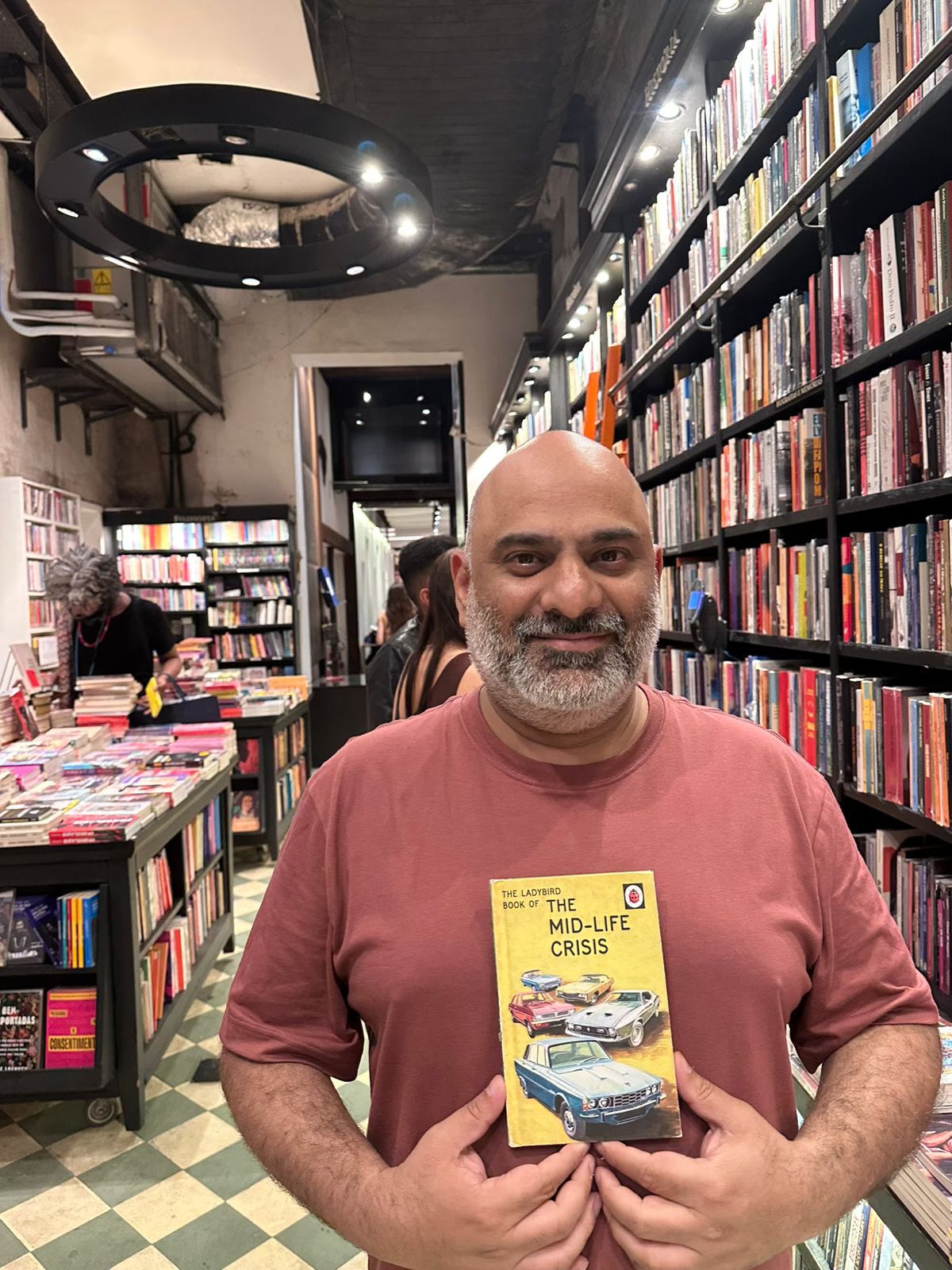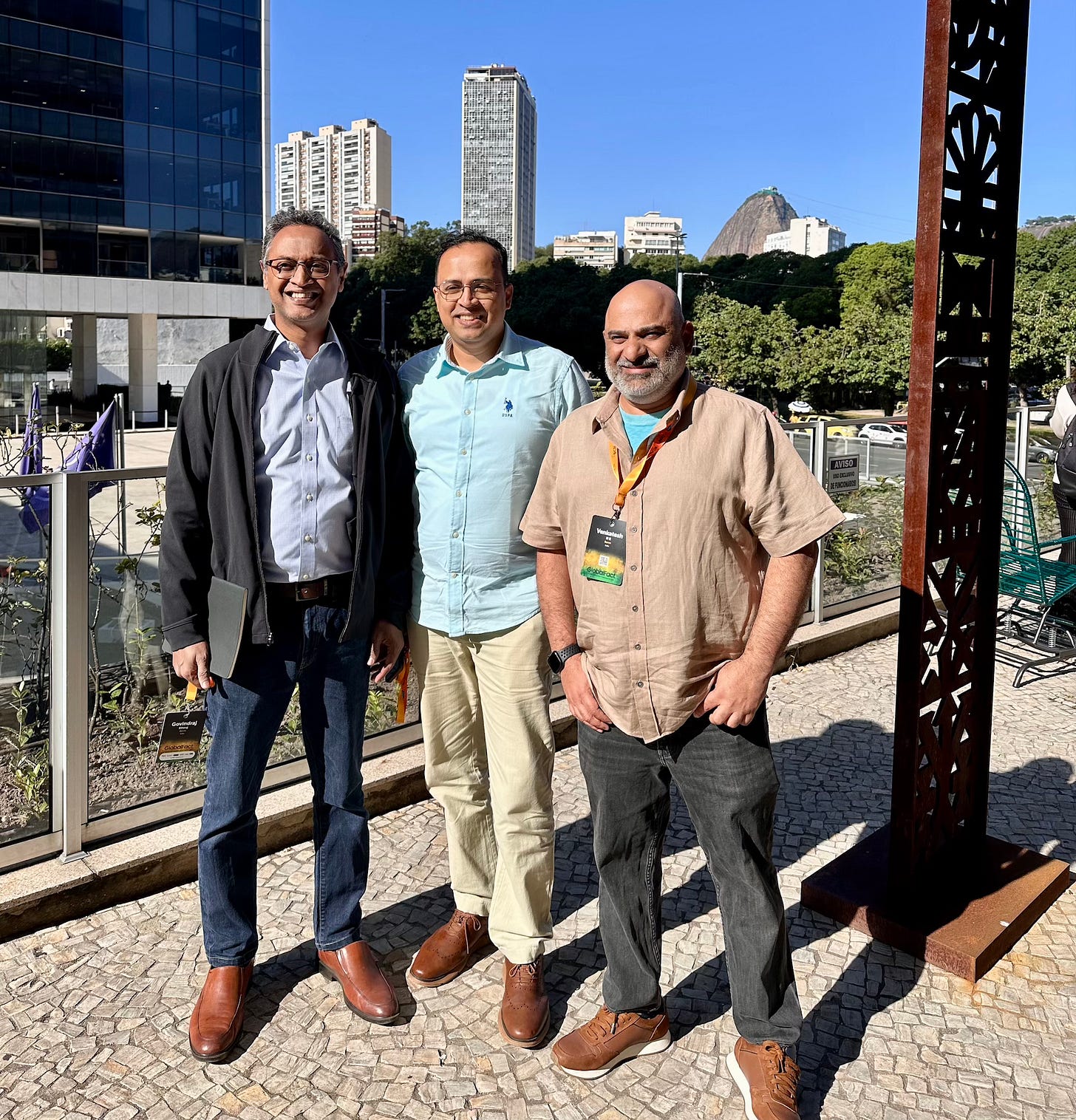I spent six days and five nights at the end of June in Rio de Janeiro at a fact-checking conference. What follows is a jumble of thoughts, photos, and videos.
For me, and I suspect, for many of us, travel is all about expanding our horizons. But this time round, I found myself curiously content with a passive state of being. I didn’t make lists of things to do or restaurants to eat at. I didn’t seek out authentic local experiences; nor did I read up on history. I was happy to be that person I never wanted to be — the unsophisticated tourist. You know, that guy who might look at a plate of feijoada and rice and say, “hey, yeh toh rajma chawal hain!”
I decided that I would take what I got, and just say ‘yes’ to everything.
It turned out to be a good strategy. I came away from Rio without my usual sense of FOMO1.
Let me begin with this image. The number on top indicates 10 Brazilian reals. Below it is 100 Indian rupees. To make 10 reals, you need approximately 1600 rupees.
Seen here, it is easy to distinguish between the two numbers. But out on the streets in Rio it is possible to get confused, as I found out.
We were at the gorgeous bookstore Livraria de Travessa in Botafogo in Rio’s financial district. As you step into the bookstore, one room telescopes into another room, and that room into another. It gives you an illusion that this bookstore, like the one in Mr. Penumbra’s 24-Hour Bookstore, will never end. The books themselves are all naturally in Portuguese, but there are two shelves devoted to books in English.
It was there that I found this amusing little book to pose with.
I also found a book that called to me: What Tech Calls Thinking: An Inquiry into the Intellectual Bedrock of Silicon Valley by Adrian Daub.
The bookstore owner said it was R$ 149 reals, which, to me sounded a bit steep but still in reasonable territory. It was only a few seconds after I’d swiped my card that I realised it actually works out to Rs. 2349.
At 150 pages, this slim book cost roughly 15 rupees per page. Unhappy with myself, I swore that I would read the hell out of it.
We were all in Rio for Global Fact, the international fact-checking conference that runs every year in a different city in the world.
Most of our time on the first few days was spent in catching up with ‘conference buddies’ and thinking about the future of fact-checking in settings like this.

Since I work remotely, it is usually only at conferences that I get to spend quality time with BOOM founder Govindraj Ethiraj and managing editor Jency Jacob.
Rio reminded me of cities in India, but with a slight twist - it felt like I was visiting an Indian city of the 2000s, or even the 1990s. The supermarkets had brands like Close-Up toothpaste, whose advertisements saw heavy rotation when I was a child. The roads were polluted, but like the Bangalore of the 2000s, and not like now. And the touts at the airport swarmed all over me until I insisted that I’d find my own way in a registered taxi, only to get cheated later anyway.
There are warnings about crime in Rio everywhere, and a number of locals warned us again and again to ensure our phones and bags were safe. Still, it didn’t stop one of the fact-checkers from having her phone stolen while out on a run. Another person, a dear friend and reader of this Substack, Masato Kajimoto, had his bag with his passport, laptop and other valuables stolen while having a pleasant dinner outside. Luckily, the thief left his passport behind in a taxi. The taxi driver who found it handed it to the Japanese Embassy who in turn reunited Masato with his passport.
At the same time, you don’t feel like you’re in personal danger in the city, at least in the daytime. Amrita Sengupta, a researcher doing a fellowship at FGV, the university where we had the conference, told me that she felt safe and free walking about, which isn’t something that one can say about most Indian cities.
In other words, Rio is a bit like an Indian city, safe and unsafe, and wholesome in ways you can’t easily quantify. An added bonus is that as an Indian, I easily blended into the crowd. I saw a few women there who could have been Tamil mamis had they just worn a saree, and men who wouldn’t have looked out of place in a Mumbai local.
With the appropriate change in body language, and a surly attitude to conceal my lack of Portuguese, I was able to fool many locals into thinking I was local. Until I opened my mouth, that is!
As a picky eater and a vegetarian to boot, I expected Rio to be a hard challenge. It turned out to be very easy though because I just ended up eating the egg option at multiple Brazilian restaurants.
On one of the conference days, we decided to eat at a Japanese restaurant about a kilometre away from Botafogo which lies on the bay. This restaurant turned out to be a food truck in a park, and the ramen turned out to be basically Maggi noodles. Still, the atmosphere was cool and breezy (with the occasional waft of urine), and we had Christ the Redeemer looking upon us as we ate a good meal.
I’ve removed the audio from the following video because we were talking shop, but you can see Jency, Abhilash Mallick and Ritu Kapur of The Quint, and Rakesh Dubbudu of Factly in it.
If you click on the link to this post, you’ll be able to play the short videos that follow right off the browser window.
Speaking of which, no trip to Rio would be complete without a visit to the famous Jesus Christ statue on top of the mountain within the city. From there, you can have spectacular views of the bay-and sea-facing regions of Botafogo, Copacabana and Ipanema.
The voices in the clip belong to me and Rajneil Kamath of Newschecker.
The view below is from Copacabana beach. If you followed a straight line from my point of view, you would end up somewhere in Antarctica.
A day earlier, Abhilash and I had signed up for a tour through downtown Rio and the famous Selaron Steps. Our tour guide was Bebeto2, a man who looked like he was in his 50s, but was actually 73. He is what you’d call a namoona - a total character.
Bebeto was inexhaustible on this hot day, insisting that we see way, way more than we’d paid for and not taking no for an answer. Occasionally as walked the city, he would punch my chest or put his arm around my neck while making a point. At all times, he spoke with force, showering us with flecks of spit.
Having decided we were good listeners, Bebeto kept aside the history-talk and dwelled at length on his relationship with his sons, and his sex life. We couldn’t take more than a couple of hours of this, but it was difficult to shake him, as he insisted on yet another stop.
But he was also generous, buying us drinks and tipping locals without taking any money from us. Here he is, with us at the gorgeous Rio de Janeiro Cathedral, which is built in the Mayan style.
Perhaps the most touristy thing I did was come back with a photo of me and a few colleagues standing at the most touristy spot in perhaps all of Brazil. Except—and here’s the kicker—this is a photoshopped photograph of us standing “in front of” the Christ the Redeemer statue.
Years later when I look back on it, I wonder if I’ll focus on how it is essentially a false memory. This is a green screen photo, and anyway the dimensions of the statue are such that no one could ever take such a picture.
Or perhaps I’ll look kindly upon a younger me, and remember the day we all took the train up a hill to catch head-spinning views of the South Atlantic Ocean and the glimmering jewel that is Rio.
Disclaimers:
All photographs and videos are by me, except where indicated otherwise.
No AI was used in the writing, editing, or production of this piece.
FOMO = Fear of Missing Out
I’ve changed his actual name for privacy.








